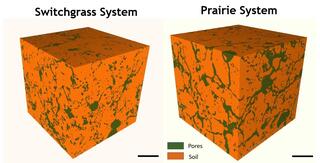Soil Pores Affect Carbon Sequestration and Greenhouse Gas Emissions from Bioenergy Systems

Stabilizing more carbon and nitrogen in the soil can reduce release of climate-warming gases, such as carbon dioxide and nitrous oxide.
The Science
Bioenergy crops have the potential to mitigate climate change by holding carbon in the soil and reducing emissions of greenhouse gases such as carbon dioxide and nitrous oxide. Roots, microbial communities, and soil characteristics interact in complex ways to regulate the movement of carbon and nitrogen among plants, soil matrix, and air. Two recent papers from researchers in the Great Lakes Bioenergy Research Center (GLBRC) at Michigan State University explore how soil properties relate to carbon and nitrogen processes in soils of bioenergy cropping systems. Their findings show that soil pore architecture together with moisture levels have a large impact on nitrous oxide emissions and carbon sequestration in soils under perennial bioenergy crops.
The Impact
A fuller understanding of the microscale factors that affect carbon and nitrogen cycling in soil will enable better estimates of the potential ecological and climate benefits of bioenergy cropping systems when established on a variety of soils and terrains. This information will also help identify bioenergy lands likely to yield the best environmental outcomes.
Summary
Soil structure—the arrangement of solid components and pores around them—has a major effect on the chemical and biological processes that occur within it. Pores, in particular, control water and air flow, regulate nutrient movement, and affect microbial decomposition of organic material. Knowing that plant roots are a major driver of soil pore formation, two new studies from Alexandra Kravchenko’s laboratory explored how changes in soil pore architecture stimulated by different bioenergy cropping systems relate to carbon cycling and carbon dioxide and nitrous oxide emissions from the soil. Both studies highlight the role that soil pore architecture can play in stabilizing carbon and reducing greenhouse gas emissions to the atmosphere.
One study, published in Scientific Reports, examined pore characteristics and carbon in the soils of two bioenergy cropping systems—switchgrass monoculture and restored prairie—in topographically contrasting terrain, either on steep slopes or in low-lying depressions. After eight years of bioenergy cropping implementation, the soils of prairie systems gained more carbon than those of switchgrass, with the greatest differences between them observed on slopes. At same the time, the soil from diverse prairie vegetation had a higher volume of pores with a radius of 30-90 µm and greater pore surface area, the two characteristics known to stimulate microbial activity and stabilization of carbon in the soil. The researchers conclude that topography can play a substantial role in regulating the ability of bioenergy crops to stabilize and sequester carbon in the soil, likely by influencing root growth and formation of beneficial soil pore architecture.
The second study, published in Soil Biology and Biochemistry, focused on how soil pore architecture and soil moisture relate to nitrous oxide emission from decaying plant roots. Nitrous oxide emissions were higher when pore architecture was dominated by larger (>30 µm) versus smaller (<10 µm) pores, and higher from wetter versus drier soils. However, the observed effect of soil pores on nitrous oxide emissions was six times greater than that of soil moisture, challenging the traditional view of moisture as the primary factor driving nitrous oxide production in soils. Organic compounds released from living switchgrass roots seem to be better incorporated into microbes in large pore-dominated soil; these later become the major source of nitrous oxide as they decompose. Together, these studies emphasize the importance of roots in shaping soil microenvironments that can alter decomposition dynamics and greenhouse gas emissions.
Contacts
Kyungmin (“Alyssa”) Kim
kk785@cornell.edu
Archana Juyal
juyalarc@msu.edu
Funding
Support for this research was provided by the Great Lakes Bioenergy Research Center, U.S. Department of Energy, Office of Science, Office of Biological and Environmental Research (Award DE-SC0018409), the National Science Foundation (Award 1904267), the NSF Long-term Ecological Research Program (DEB 1832042 and DEB 1027253) at the Kellogg Biological Station, Michigan State University AgBioResearch, and the “RUDN University program 5–100.”
Publications
K. Kim, et al. Soil pore architecture and rhizosphere legacy define N2O production in root detritusphere. Soil Biology and Biochemistry 166, 108565 (2022). [DOI: 10.1016/j.soilbio.2022.108565]
A. Juyal, et al. Pore architecture and particulate organic matter in soils under monoculture switchgrass and restored prairie in contrasting topography. Scientific Reports 11, 21998 (2021). [DOI: 10.1038/s41598-021-01533-7]
Related Links
https://www.sciencedirect.com/science/article/pii/S0038071722000220